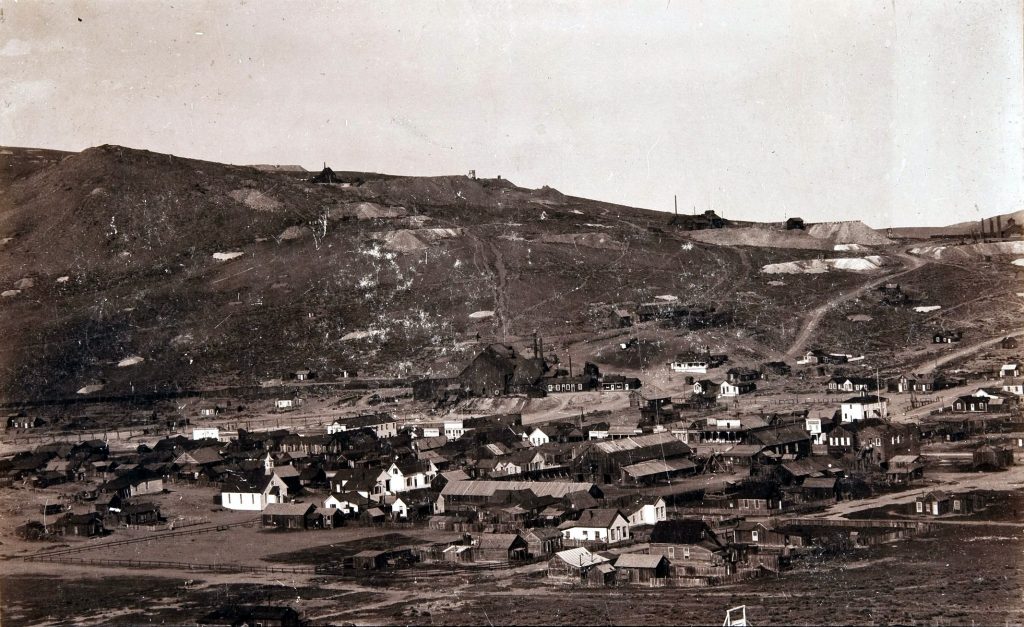Dust blows across an empty gravel road. Abandoned wooden buildings stare up at an empty bluff. Down the town’s long road, just past the church and collapsed bank, is an incline shaft. The shaft is dead, and so are the ghosts that supposedly haunt it and the town. This town, Bodie, hasn’t been alive since the 1950s.
Originally, Bodie was a mining camp founded by a handful of Californians, including Pat Garraty, William Boyle, Terrence Brodigan, and W. S. Bodey (who was the one to name Bodie). The group stumbled upon gold-filled ground around 1858, only to move on hoping to return in the spring. However, Bodey had other plans. With another companion, Bodey returned to the site with more supplies to survive the deathly winter. After winter passed and word of the fertile mines spread, the mining camp filled with more new inhabitants hoping to find great wealth.1.
Even though the mining camp was filling with people, it still lacked a name. It wasn’t until the following winter, in November of 1859, that Bodey died trapped in a blizzard while on a trip to get more supplies. In honor of his death, the camp would be called “Bodey’s Diggings” or “Bodey” for short, which would later be adapted to Bodie. 2.
But how did this mining camp grow into a town and then later into a ghost town?

With gold mining cities in close proximity to Bodie, the hunt for various ore in the area was on. Everyone wanted their own piece of the gold pie. In 1863 and 1864, mineralogist and geologist William P. Blake and Professor of Chemistry Benjamin Silliman traveled to Bodie to inspect the veins, concluding that “Bodie’s Mines showed great promise.”3 Soon after, the Empire Company purchased property in Bodie with the prospects of opening new mines, and the Bodie Bluff Consolidation Mining Company, the Bodie Consolidation Gold, and Silver Mining Company followed suit. The more companies invested into the site, the more the town grew in both population and profit. Bodie was starting to boom.4

The town grew as over 100 hand miners began to flow into Bodie along with at least 50 Empire Company workers. Already, two stores had opened and the preparation “for numerous whiskey mills and hash houses” was underway, as an onlooker from Inyo Country wrote in 1877. This sort of growth suggested that the town would grow to be more than just a mine, becoming instead a place for families to settle. Bodie was becoming a place for miners to make profit and for businesses as well. Stocks began to sell for one dollar a share, adding to the total profit of Bodie. 5
As more residents discovered gold, more men came into the town. By 1879, the population of Bodie was between 5,000 and 7,000.6With twenty-five mines open, the flow of money to miners was constant, incentivizing the hard working men to settle down. As predicted, Bodie was no longer just a mining town full of men looking to strike it rich. It was becoming an established town, in which families could move into alongside miners. Because of the permanent residents, the town had built up the Bodie House, a hotel, with the Miners Union Hall immediately behind it, and the Champion, Grand and Oakland House hotels provided housing, restaurants, and a barber shop. It was no longer a standard camp, set up for miners to dig, get their pay and leave. Solid buildings meant to last through the harsh winters were constructed, replacing temporary tents. The town had even acquired their own newspaper, The Daily Bodie News, as well as a real estate office immediately next door, ensuring incoming families that there would be permanent residency for them.7
It wasn’t until 1880 that Bodie started to show signs of decline. Single, young miners looking to strike rich, quickly grew tired of the wage pay that the Bodie mines had instilled. They began to move away to nearby mining towns where they were paid based on the quantity of gold mined, rather than on hours worked. Although family settlers remained, much of the mining workforce was beginning to branch off into other directions.8 Although there was a short revival with new technologies, mines still began to close. In previous years, production had reached as high as three million dollars in both gold and stock profit in 1881, 9 but by the early 1900s, profit had severely plummeted as workers left and mines became less productive. In 1914, the profit shrunk under $7,000, only spiking in the 1915 when there was an attempt to revive a previously closed mine. Although profits climbed back to $1oo,ooo, it would never equal the booming millions that the mines had originally experienced. Eventually costs would be too high for all mines to stay open. 10
Finally, World War II forced Bodie’s last producing mine to shut down. Mining never resumed once the war was over, but in 1961, the town was declared a National Historic Landmark. The following year, the state authorized Bodie to become its own State Historic Park. Today a total of 170 buildings survive in Bodie with just over 100 still standing perfectly intact. Each building has been preserved and remnants of the daily life of a Bodie citizen can still be seen inside each house and building. Even the mines have been preserved, and there are many tours that can take curious onlookers around the supposedly haunted ghost town. 11.

- Michael Piatt, Bodie: “The Mines Are Looking Well…” (Al Sonbrante, TX: North Bay Books, March 2003), 21. ↵
- Wikipedia, 2018, s.v.“Bodie, California” ↵
- Michael Piatt, Bodie: “The Mines Are Looking Well…” (Al Sonbrante, TX: North Bay Books, March 2003), 23. ↵
- Wikipedia, 2018, s.v.“Bodie, California”. ↵
- Michael Piatt, Bodie: “The Mines Are Looking Well…” (Al Sonbrante, TX: North Bay Books, March 2003), 39-41 ↵
- Wikipedia, 2018, s.v.“Bodie, California” ↵
- Michael Piatt, Bodie: “The Mines Are Looking Well…” (Al Sonbrante, TX: North Bay Books, March 2003), 88. ↵
- Wikipedia, 2018, s.v.“Bodie, California” ↵
- Michael Piatt, Bodie: “The Mines Are Looking Well…” (Al Sonbrante, TX: North Bay Books, March 2003), 41; Wikipedia, 2018, s.v.“Bodie, California” ↵
- Wikipedia, 2018, s.v.“Bodie, California” ↵
- California State Parks, State of California. “Bodie SHP.” CA State Parks. Accessed September 15, 2018. http://www.parks.ca.gov/?page_id=509. ↵



50 comments
Thalia Romo
Having grown up in a big city like San Antonio, it’s hard to imagine it declining in population, service and businesses. However, since mine workers started to experience a decline in wages, it would only make sense for them to retreat from the area and find something that would better suit their needs and wants. This article good job at stating how the decline for Bodie came to be, whether that was due to wages being cut, war approaching, or the coal plants being shut down.
Vanessa Quetzeri
I think it is very interesting to find a reasoning for why ghost towns became ghost towns. To think that a place could be as successful as Bodie and then suddenly wane out is beyond me. Although, it does make sense that these settlers were looking to become rich, found an operation but then word gets out. So the miners grew tired of their wages, the city started declining, and then the citizens began to branch out of Bodie.
Christopher Metta Bexar
I found the article interesting because it filled in so many gaps for me. I lived most of my life in Southern California and had visited ghost towns, including Bodie.
The ranger there seemed too busy to discuss the town’s history, so I’m glad for the article.
Like another reviewer said so many towns were just for single men looking to get rich quick and much of them didn’t survive.
I’m glad we still have Bodie.
Averie Mendez
The introduction was very well written. Reading it really gave off the eerie vibe of the town, and set the mood for the entire article. I had never heard of Bodie before, but I’ve read countless stories of towns abandoned by its citizens after they failed to strike riches in the 19th and 20th century. I feel like ghost towns have a bad reputation due to their portrayal in recent horror movies, but, personally, I think it’s sad how abandoned and empty they are.
Eric Ortega Rodriguez
This is the first time I hear about the town of Bodie. I find it fascinating how much the mining business appealed to people, and now it is just a ghost city. Something that I still find bizarre is that even though it might be a ghost city, it still attracts tourist. Overall, I really enjoyed reading this article and it makes me want to look more into more ghost cities. Overall, great article with a really original topic selection.
Victoria Salazar
That is pretty cool. I think it is interesting how one town’s beginning to end could be recorded. I guess it’s like the rising and falling of any of the other empires and settlements that we read about in history books. Although, for some reason Bodie has a different feel to it. It was a town filled with young, single, miners and families of all ages. It makes me think that it was one of those town where everyone knew everyone – a real neighborly feel.
Michael Hinojosa
After reading the title I knew this article was going to be interesting, and I’m glad to know my gut feeling was correct! Ghost towns have always been an interesting topic to me so I wasted no time clicking on this article to add to my knowledge. It was also cool to learn a bit more about the gold rush since my school never really went too in-depth into it other than the fact that it was a thing and that it existed and happened in our history.
Felicia Stewart
Ghost towns are always so interesting to me! Reading the title of this article is what made brought in my attention. I personally have never heard specifically of Bodie. I have personally seen towns turn into ghost towns and it is so interesting how a place can go from being one of the busiest, due to some type of business or resource, like mining in Bodie, and all of a sudden be a dead town with nearly no one in it. This was a great article and a great read!
Tala Owens
It is so interesting to read about ghost towns. This town is like stepping back in time if you were to visit it. It is so crazy how this place can go from a place filled with people and a booming mining business to a town that is completely empty all because of money problems. People lived there and were happy and making money, but it soon came to an end. This was a good read and I liked the pictures provided in the article, it really looks like another nice, small town. Very interesting!
Hali Garcia
I love reading about ghost towns! This is a very interesting article because I have never even heard of Bodie. The Gold Rush has always been interesting to me but I have not really looked deeply into it. It is interesting to read about how they were starting out to be just a mining camp that would later become a town were people could live. It makes sense in the mining industry that later miners would leave for better paying opportunities. Overall, this is a great article.